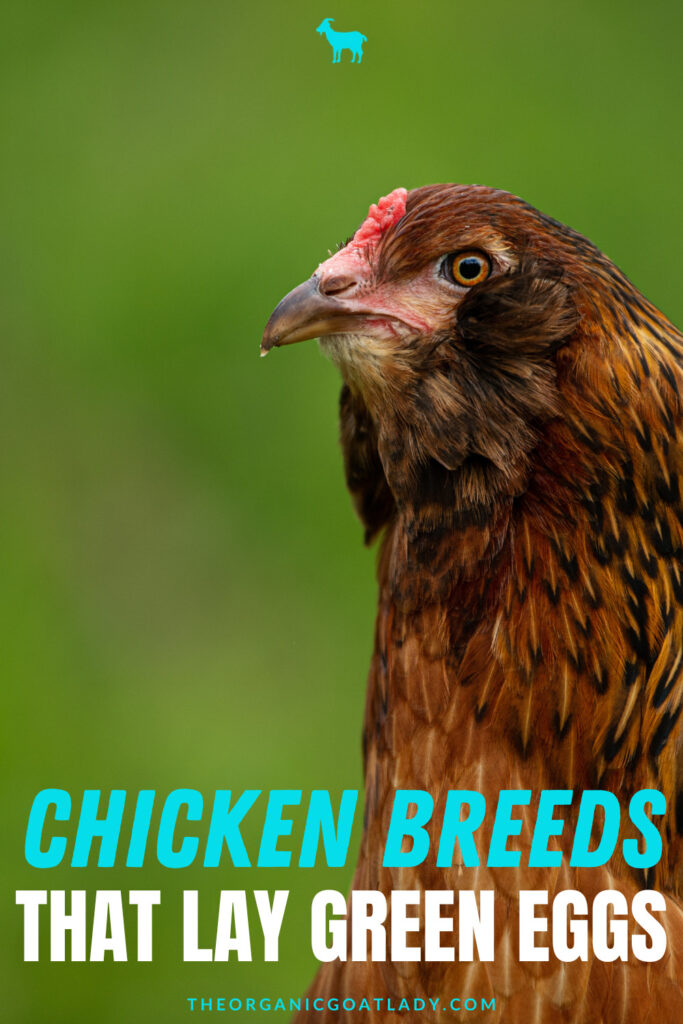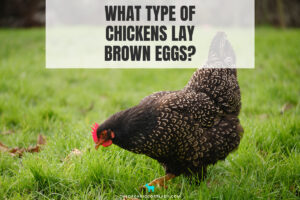Raising backyard chickens means you have the opportunity to raise unique birds and birds that lay different colored eggs. Here is a list of chicken breeds that lay green eggs.
This site contains affiliate links. If you make a purchase using one of these links, I may earn a commission. Please click here for more information about cookies collected and our privacy policy.

Chicken Breeds That Lay Green Eggs
Fresh eggs from your own backyard chickens can’t be beat!
Unless your backyard chickens are laying olive eggs or green-colored eggs instead of just white eggs! Having a backyard flock of different type of chickens that provide beautiful eggs of different shades makes raising chickens even better.
While there are many types of chickens to choose from, there is one primary chicken breed known for laying green eggs:
Araucana Chickens
Araucanas are a breed of chicken originally from Chile. They are famous for their distinctive blue-green eggs. The color is a result of a blue eggshell pigment combined with a brown pigment, resulting in a greenish hue. Araucanas come in various color varieties and have unique tufted earflaps and no tails.
It’s important to note that the green eggs laid by Araucanas can vary in shade and intensity, and not all individuals within the breed will lay eggs of the same color. Additionally, there are some other breeds and hybrids that might lay eggs with a greenish tint, but Araucanas are the most well-known for consistently producing green eggs.
Araucana chickens are a distinctive breed known for their unique appearance and the blue or green eggs they lay. Here’s a comprehensive overview of Araucana chickens:
1. Origin: Araucana chickens originate from South America, specifically from the Araucanía region of Chile. They are believed to have been bred by indigenous peoples in the region for their colorful eggs and hardiness.
2. Appearance: Araucanas are easily recognizable by their tufted earflaps, often referred to as “ear tufts,” which are a genetic trait unique to the breed. They have a rumpless (tailless) trait as well, which means they have a very short or non-existent tail. Their body type is generally compact, and they come in a variety of colors and feather patterns.
3. Egg Color: One of the most distinctive features of Araucana chickens is the color of their eggs. They lay eggs with blue or green shells, which is a result of the interaction between blue and brown pigments during eggshell formation. The specific egg color can vary from pale blue to mint green chicken eggs.
4. Size: Araucana chickens are generally small to medium-sized birds. Roosters typically weigh around 5-6 pounds (2.3-2.7 kg), while hens usually weigh around 4-5 pounds (1.8-2.3 kg).
5. Temperament: Araucanas are known for having friendly and inquisitive personalities. They can make good additions to backyard flocks and are generally docile and easy to handle.
6. Egg Production: While Araucanas are not known for their prolific egg-laying abilities like some commercial breeds, they can still lay a reasonable number of eggs. However, egg production varies widely depending on individual birds and breeding lines.
7. Conservation Status: Araucana chickens are recognized as a heritage breed, but they are not as common as some other commercial breeds. They have a small gene pool, which makes their preservation and conservation important to maintain genetic diversity within poultry populations.
8. Crossbreeds: It’s worth noting that sometimes chickens sold as “Araucanas” are actually crossbreeds known as “Easter Eggers.” These birds often have the blue egg gene but may lack the distinct tufted earflaps or rumpless trait of true Araucanas. Easter Eggers can lay eggs in various colors, including blue, green, and shades in between.
Overall, Araucana chickens are beloved by enthusiasts for their unique traits, colorful eggs, and engaging personalities. If you’re interested in raising Araucanas, be sure to source them from reputable breeders to ensure you’re getting true representatives of the breed.
Araucanas are the primary breed known for consistently laying beautiful green eggs. While there are other chicken breeds that might lay eggs with a slight greenish tint, they do not consistently produce true green eggs like Araucanas do.
However, it’s worth mentioning that some breeds are often confused with Araucanas due to their similar appearance, and they might lay eggs with a slight greenish hue. These breeds include:
Easter Egger Chickens
Easter Egger chickens, often referred to as “Easter Eggers,” are a type of chicken that is not a pure breed but rather a mixed-breed chicken that carries the blue eggshell gene. They are known for laying eggs in various shades, including blue and green.
Here’s more information about Easter Egger chickens and their egg colors:
1. Genetic Background: Easter Eggers are not a standardized breed like Araucanas or Ameraucanas, but rather a mix of different breeds. They often have genetics from breeds like Ameraucana chickens, Araucana, or other blue egg layers, as well as other breeds that contribute to their appearance and other traits.
2. Egg Colors: The eggshell color of Easter Egger chickens can vary widely. Their eggs can be blue, green, or shades in between, often ranging from a pale blue to a light green or turquoise color. The variability in egg color is due to the genetics inherited from their diverse parentage.
3. Appearance: Easter Eggers come in a wide range of colors, patterns, and feather types. Their appearance can be quite diverse, and they often have a more “rustic” or “homestead” look compared to standardized breeds.
4. Temperament: Like with any mixed-breed chickens, the temperament of Easter Eggers can vary. However, they are generally known to be friendly and adaptable birds that can be a good fit for backyard flocks.
5. Egg Production: Easter Eggers can be decent egg layers, with egg production varying based on individual birds and their genetics. They are often kept by backyard poultry enthusiasts for both their colorful eggs and their engaging personalities.
6. Popularity: Easter Eggers are popular choices for those who want to enjoy a variety of egg colors and the surprise of not knowing exactly what colors their hens will lay. They are commonly available in feed stores and from breeders who work with mixed-breed chickens.
Keep in mind that since Easter Eggers are not a standardized breed, there can be a lot of variation in their traits, including egg color, size, appearance, and temperament. If you’re interested in getting Easter Eggers, it’s a good idea to obtain them from reputable sources to ensure healthy and well-cared-for birds.
What Chickens Lay Olive Colored Eggs?
Olive Egger Chickens
Olive Egger chickens are a type of hybrid chicken that are bred specifically to lay eggs with olive-colored eggs. They are created by crossing a blue egg layer or green egg egg layer (often Ameraucana or Araucana) with a chicken that lays dark brown eggs (like Marans).
Here’s more information about Olive Egger chickens:
1. Egg Color: The primary defining feature of Olive Egger chickens is their egg color. The unique olive green egg color is a result of the interaction between the blue or green eggshell gene from one parent and the dark brown eggshell gene from the other parent.
2. Genetic Background: Olive Eggers are not a standardized breed but rather a hybrid created through specific crossbreeding. They are bred for the purpose of producing eggs with a particular color, rather than conforming to specific breed standards.
3. Variability: The appearance of Olive Egger chickens can vary widely, as they inherit traits from both parent breeds. Their appearance may include a variety of colors, feather patterns, and other characteristics.
4. Temperament: Like with any mixed-breed chickens, the temperament of Olive Eggers can vary based on their parentage. However, they are often chosen for backyard flocks due to their engaging personalities.
5. Egg Production: Olive Eggers are typically bred to be good egg layers, with a focus on egg color. They can lay eggs in shades ranging from light olive to darker olive, depending on the specific genetics involved in their crossbreeding.
6. Availability: Olive Eggers are not as standardized or common as some other breeds, and they might not be as readily available as commercial breeds. They are often found through specialty breeders or backyard poultry enthusiasts who are interested in breeding for unique egg colors.
7. Breed Names: Olive Eggers don’t have a specific breed name, as they are hybrids. The name “Olive Egger” generally refers to chickens resulting from the specific crossbreeding of blue/green egg layers with dark brown egg layers.
If you’re interested in raising Olive Egger chickens, it’s important to work with breeders who are knowledgeable about the genetics involved in creating this hybrid. These chickens can add a fun and colorful twist to your egg basket, and their unique appearance and egg color make them a popular choice among poultry enthusiasts.
Remember that egg color can vary even within a single breed due to factors like genetics, diet, and individual variation. If you’re specifically interested in green eggs, Araucanas are the most reliable choice for this trait.
Why Do Some Chickens Lay Green Eggs?
Some chickens lay green eggs due to a genetic trait that affects the color of their eggshells. The blue-green eggshell color is a result of the interaction between two pigments: protoporphyrin (a brown pigment) and biliverdin (a blue pigment). Chickens that lay green eggs have a specific combination of these pigments that results in the greenish hue.
The genetic basis for this eggshell coloration is found in chicken breeds like the Araucana. These breeds have a specific allele of the “blue eggshell” gene that influences the distribution and concentration of the pigments on the eggshell. The blue eggshell gene is often associated with the tufted earflaps that Araucanas typically have.
The process of eggshell pigmentation occurs as the egg travels through the hen’s oviduct. The pigments are deposited onto the eggshell during the last stages of egg formation. If the eggshell has a higher concentration of the blue pigment biliverdin and a certain amount of the brown pigment protoporphyrin, the egg appears green.
It’s important to note that egg color can vary even within a single breed due to factors like genetics, diet, and individual variation. So, while some chickens consistently lay green eggs, the exact shade and intensity of green can differ.
Brown Egg Layer
If you would like a flock that can provide different colors of eggs, then also include one of these breeds that lay eggs with a brown color. This list contains many breeds of chickens that will produce beautiful brown eggs!


